Here’s the scenario.
You’re launching a marketing campaign and you want results that you can actually measure.
You also want the most bang for your buck.
You need confidence that the time and money you invest will bring in a steady stream of qualified traffic that’s primed to convert.
In other words, you want a rock-solid ROI.
There are lots of channels to try, but most decisions start with two: SEO or PPC.
Both can reliably drive targeted leads to your site.
So which one makes the most sense for your campaign?
And more importantly, which should you prioritize first?
Below, we walk through the real pros and cons of each option, based on hands-on experience.
By the end, you’ll know exactly which path—or mix of both—fits your goals.
By the numbers
We’re big fans of letting data guide decisions.
It’s easier to choose wisely when you take the emotion out of it and look at the facts.
Here are a few current realities to keep in mind about SEO and PPC.
SEO Stats
- Most online journeys still include a search—especially for research and comparison.
- For many non-branded and informational queries, organic results capture the majority of clicks.
- SEO leads often close at higher rates than traditional outbound because intent and timing are stronger.
- Google handles trillions of searches each year, which means compounding opportunities if you rank consistently.
- Marketers consistently report positive ROI from SEO over a 6–12+ month horizon when content quality and site experience are strong.
PPC Stats
- Paid visitors commonly convert at higher rates when campaigns target high-intent keywords and match offers to that intent.
- High-intent searches frequently trigger ads at the top of results, letting you capture demand immediately.
- Search ads can lift brand awareness and assist conversions across other channels.
- Many companies use PPC for direct response and to validate new offers fast before scaling via SEO.
- Well-managed accounts can deliver strong ROAS, but efficiency varies by industry CPCs, competition, landing page quality, and measurement setup.
Bottom line: both strategies can produce excellent outcomes.
If you plan and execute well, you’ll earn qualified traffic and a meaningful share of that traffic will convert.
The path to get there is different, though—which is why choosing the right starting point matters.
Let’s look at the trade-offs.
The advantages of SEO
The biggest draw of SEO is cost efficiency over time.
You don’t pay for each click, so you avoid the ongoing media spend that comes with PPC—though you will invest in content, technical work, and promotion.
To see why CPCs add up fast, here’s a quick look at averages by industry from WordStream:
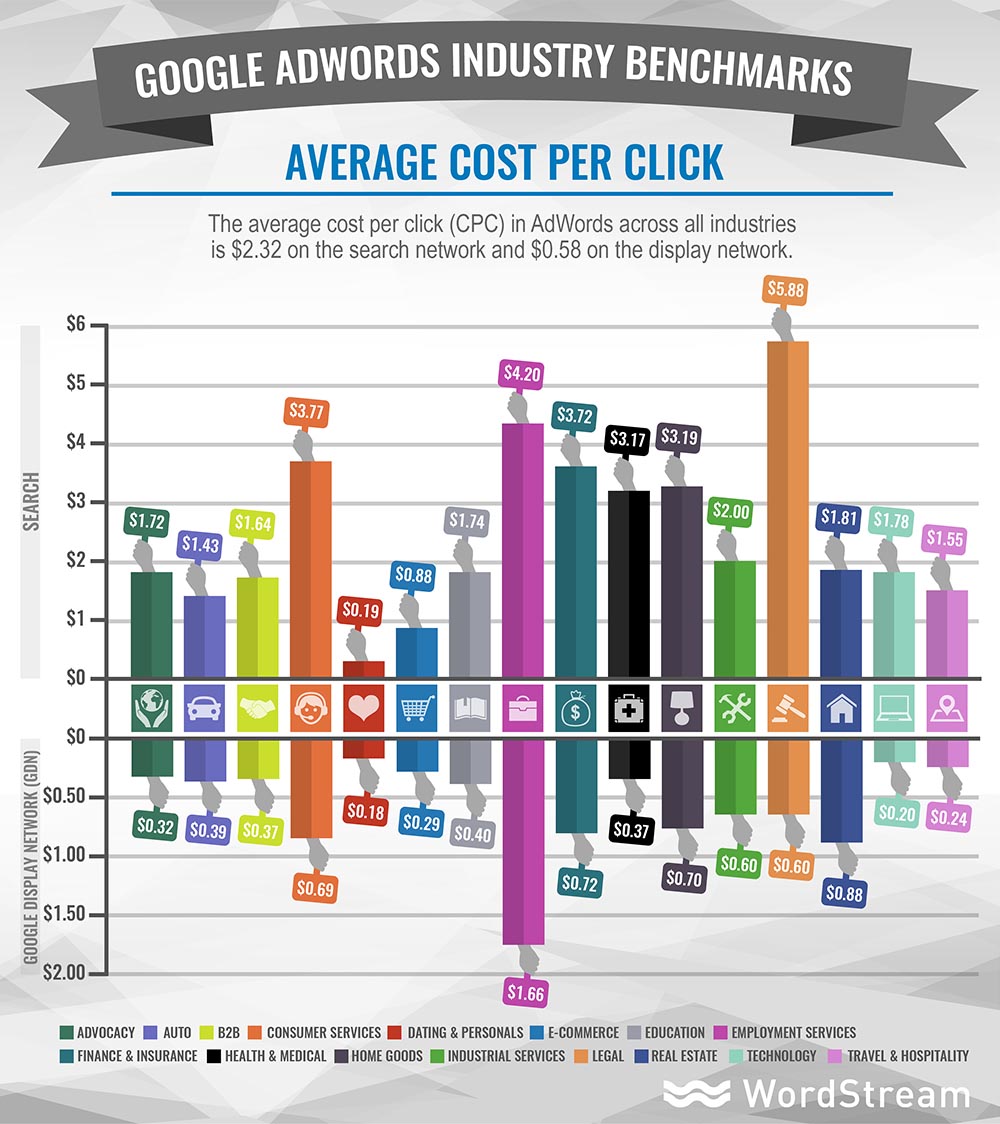
Certain verticals—like legal—are notorious for high CPCs, which can make paid acquisition pricey fast.
Getting PPC off the ground usually requires a meaningful budget.
And if you’re new to it, there’s a learning curve before your CPA and ROAS stabilize.
SEO typically requires more time than cash, making it the logical choice when budgets are tight.
Another major upside is the compounding, long-term growth.
Here’s a simple visual showing how organic performance compounds compared to paid:
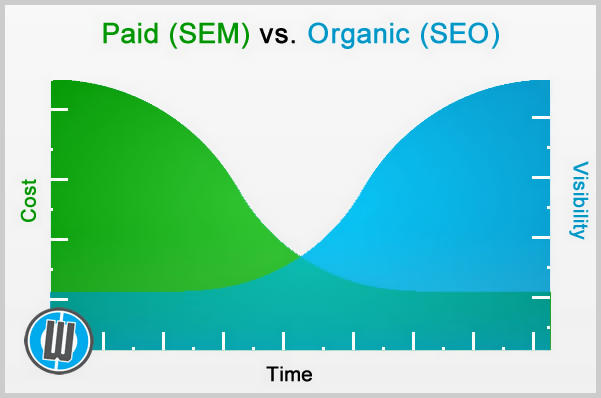
SEO often starts slowly, then snowballs as you build topical depth, earn links, and improve site experience.
That makes it more sustainable than PPC, with the potential for durable, high-quality traffic for years.
Finally, the ROI can be excellent.
Yes, SEO isn’t “free”—content and tech work cost time and money.
But when rankings stick and content is refreshed periodically, marginal traffic costs trend toward zero, and returns improve month after month.
Even if you ease off the gas, a well-built library of content can keep bringing in visitors.
That ongoing exposure compounds brand trust and conversion volume.
The advantages of PPC
The standout advantage is speed.
Turn on a well-targeted campaign and you can see qualified traffic quickly—sometimes the same day:
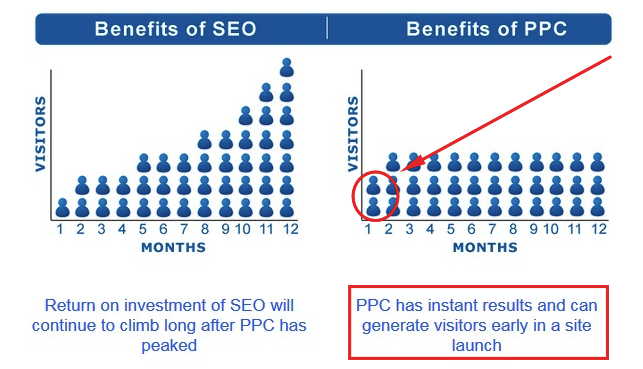
Right away, you can reach ready-to-buy audiences.
You can also focus on keywords and audiences with strong buying intent and tailor messaging tightly to them.
This is especially useful for new brands without much organic visibility yet.
PPC boosts traffic and brand exposure in a hurry, and it’s unbeatable when you need results now.
Another plus: conversion rates.
While you may spend more overall, paid search visits are often more likely to convert because ads, offers, and landing pages can be tuned to match intent precisely.
There are also more viable channels than ever.
Google Ads still dominates (most advertisers run there), but you’ve got options.
Microsoft Advertising can be more cost-effective in some industries, and social platforms like Facebook and Twitter/X offer robust paid options for demand capture and retargeting.
The point: you’re not limited to Google Ads.
The downside of SEO
It isn’t all sunshine and instant wins.
A common frustration is volatility from search engine updates.
Major changes over the years have reshuffled results, and sites that rely on thin content, weak UX, or manipulative link tactics tend to feel it the most.
SEO isn’t a set-it-and-forget-it channel—it needs ongoing maintenance, content improvements, and attention to user experience.
Penalties
No one likes the idea of a penalty or manual action.
Even with good intentions, risky tactics can backfire and erode trust.
The safest approach is to use white-hat practices, build genuinely useful content, and avoid shortcuts that promise quick wins but carry long-term risk.
Keep an eye on industry news and stay current on major algorithm updates so you can adapt early.
It takes time to see results
If patience isn’t your thing, SEO can be frustrating.
It rarely delivers meaningful, overnight gains—especially on competitive topics.
Even with strong content and links, meaningful ranking movement often takes weeks to months.
Indexing can be quick, but ranking reliably takes longer as search engines assess quality, relevance, and user signals.

Timelines vary by site authority and competition, so plan for the long haul and iterate continuously.
Stick with it, and the payoff compounds.
Reaching page one is no guarantee
Every SEO’s core goal is simple:
Get your content onto page one for the right terms.
That’s the game.
But there are no guarantees—competition is fierce and ranking factors are nuanced.
Even if you execute well, countless variables determine where you land in the SERPs.
Missing page one is deflating—and costly—because attention drops off sharply after the top results.
Considering “most users rarely go past the first page,” you’ll struggle to drive volume if you fall short.
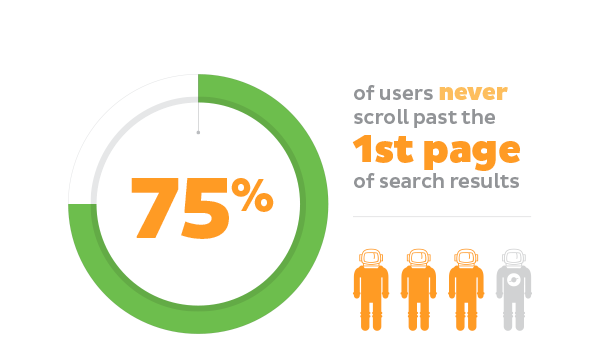
Want to quickly check how you rank for key terms? Here’s a simple way.
Head to Semrush.
Enter your domain.

Click “Start now.”

Scroll to “Top Organic Keywords” and hit “View full report.”

Review positions, trends, and opportunities to improve relevance and click-through.
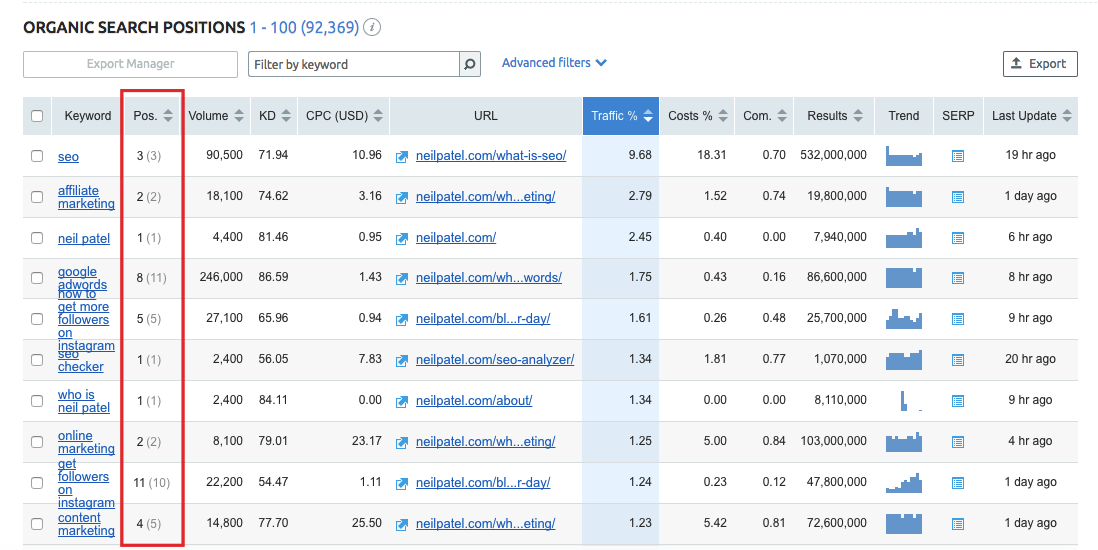
The downside of PPC
PPC usually comes with higher upfront costs.
And that’s the sticking point for many marketers.
Look at some of today’s most expensive keywords:
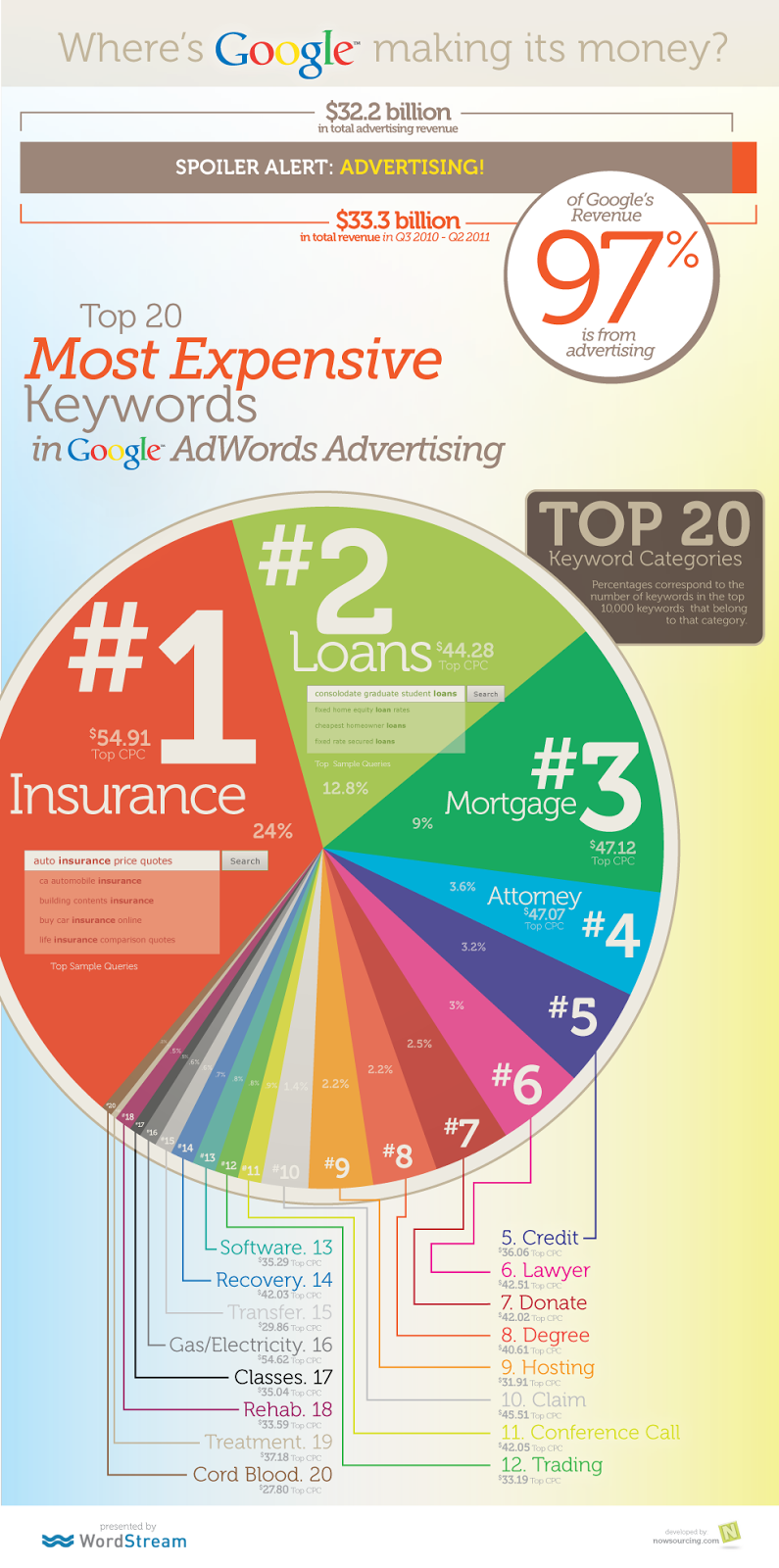
Terms like “insurance” can get extremely pricey.
And costs have generally trended upward as more advertisers compete for the same clicks.
Google Ads can be cutthroat in competitive niches.
In some cases, acquisition costs can outpace what you earn unless your funnel, pricing, and lifetime value are dialed in.
If you’re a bootstrapped startup, PPC may not be realistic at first from a cost perspective.
Optimizing your ads can be difficult and time consuming
You can’t just throw up ads and expect a flood of perfect traffic.
Even learning the basics takes time.
Dialing in bidding, audiences, creative, and landing pages to improve CTR and CPA takes longer—especially with evolving privacy changes and conversion tracking requirements.
Expect a ramp-up period where efficiency improves as you test and learn.
Until then, you may spend more than you’d like.
Your traffic ceases when your campaign ends
Here’s the harsh reality.
When you stop funding your PPC campaigns, the traffic stops too.
No spend, no clicks—and no PPC-driven sales.
Other channels like SEO, email, or social can keep working even if you slow down for a bit.
PPC doesn’t; it requires ongoing budget to maintain volume.
Plan accordingly so you’re not overly dependent on paid traffic for core revenue.
Examining all the angles
We’ve covered the good, the bad, and the trade-offs for both SEO and PPC.
Like any channel, each has strengths and weaknesses.
Before you commit, evaluate your timeline, budget, competitive landscape, and internal resources—then choose the mix that aligns with your short- and long-term goals.
When you should focus on SEO first
If you’re working with a small budget, PPC may not be feasible initially—so SEO is the clear choice.
In that case, invest time into technical health, helpful content, and internal linking.
It’s not the easiest path, but it typically delivers a strong ROI as momentum builds.
You’re looking for long-term sustainability
Think of SEO like getting a massive boulder moving.
The initial push is heavy, but once it’s rolling, momentum takes over.
That momentum compounds as your library of high-quality content grows, lifting traffic, leads, and sales.
Stick with it, and you can rank for competitive terms in your space.
Consistency wins here.
You don’t need instant results
SEO is a long-game.
Meaningful results take time, especially for newer brands.
If you can wait for momentum to build and you’re committed to improving pages based on real user feedback, SEO makes perfect sense.
Here’s the kind of trend you can see from a sustained SEO program:
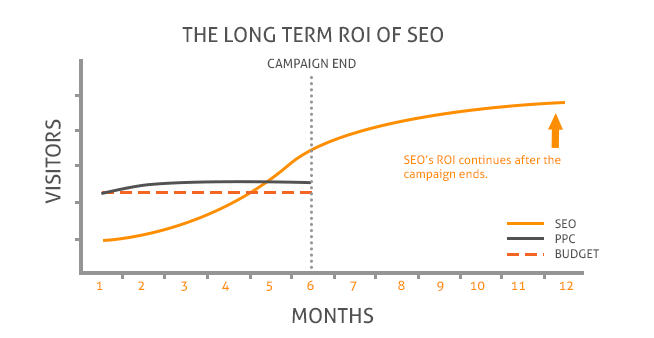
Early months can feel slow.
But momentum typically accelerates around the mid-term as more pages rank and click-through improves.
If you can wait for that tipping point, SEO is usually your highest-leverage bet.
When you should focus on PPC first
A PPC-first plan works best when two things are true.
You have A) a meaningful budget and B) a need for quick, predictable results.
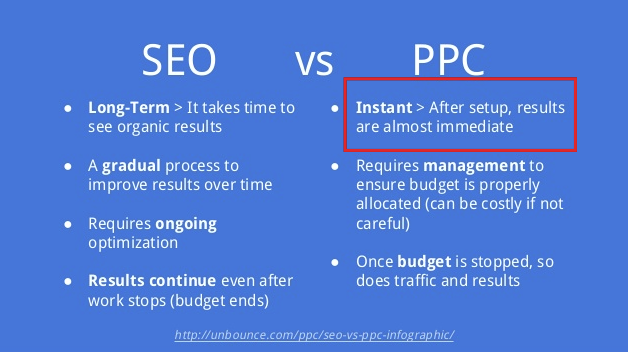
Launch your campaigns, choose your keywords and audiences, set budgets, and you can see a meaningful influx of traffic fast.
Sometimes within 24 hours.
That exposure puts your offer in front of your market with minimal ramp-up.
Follow best practices—tight intent matching, relevant ad copy, fast pages—and the ROI can be strong.
It may cost more than SEO in the long run, but the payoff is faster and requires less content production.
If you go the PPC route, remember you’re not locked into Google Ads alone.
Google Ads still works, absolutely.
But many advertisers use Microsoft Advertising to reach a different audience at potentially lower CPCs in some niches.
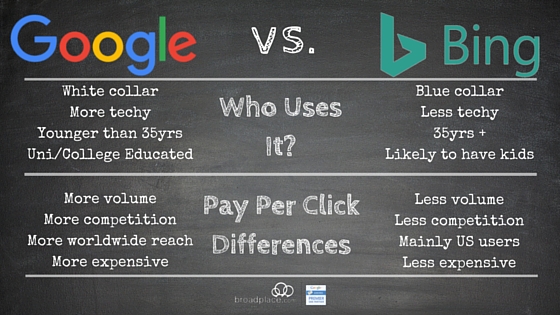
Facebook offers a mature ads platform too, and with over three billion monthly users, odds are your audience is there.
Want more ideas beyond Google Ads? See this guide from PPC Hero.
When to use both—SEO + PPC together
In many cases, the highest ROI comes from pairing them.
Use PPC to capture high-intent demand immediately while you build SEO moats for long-term, lower-cost traffic.
Share data both ways: let PPC query data and ad copy testing inform SEO titles and meta descriptions, and let SEO reveal new keywords to bid on profitably.
Set guardrails so paid budgets prioritize terms where organic visibility is weak or SERPs are ad-heavy, and reduce bids where you consistently own top organic spots and paid cannibalizes clicks.
A quick decision framework
If you need pipeline fast and have budget: start with PPC, validate offers and messaging, and reinvest learnings into SEO.
If you’re budget-constrained but time-rich: focus on SEO—fix technical issues, build useful content that matches search intent, and refresh pages regularly.
If you can do both: run a lean PPC layer for demand capture while building durable organic visibility.
Conclusion
When a brand launches a campaign, SEO and PPC usually get the first look.
Both can produce great results—but they do it in different ways.
SEO is planting seeds and letting compounding take over.
It takes time, but as rankings strengthen, your brand earns durable visibility and lower-cost growth.
The best part is the compounding effect once you pass the early curve.
PPC is about speed and precision.
It costs more upfront, but the results are nearly immediate and highly controllable.
You can go from unknown to visible quickly with the right targeting and landing pages.
The catch: costs persist, and it lacks SEO’s long-term sustainability.
There isn’t a single “best for everyone” answer.
Your choice depends on your budget, timeline, competition, and goals.
Use the trade-offs and frameworks above to decide where to start—and don’t be afraid to blend both for the strongest overall ROI.
